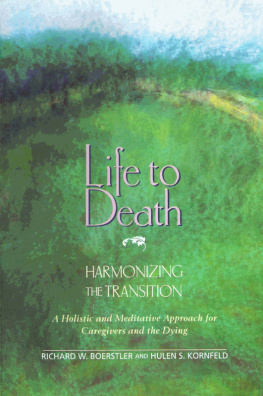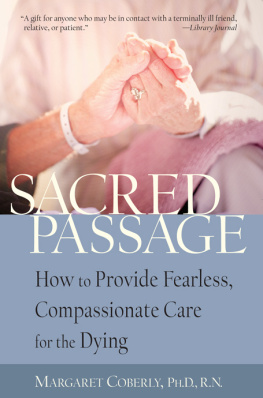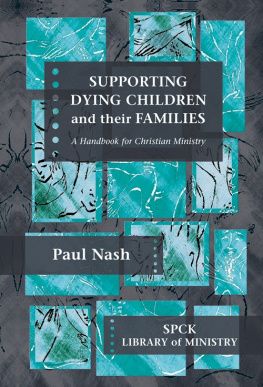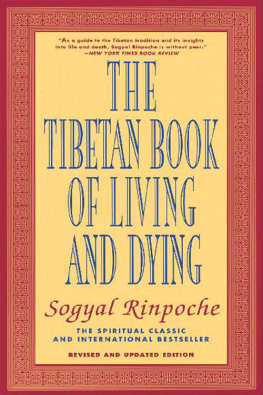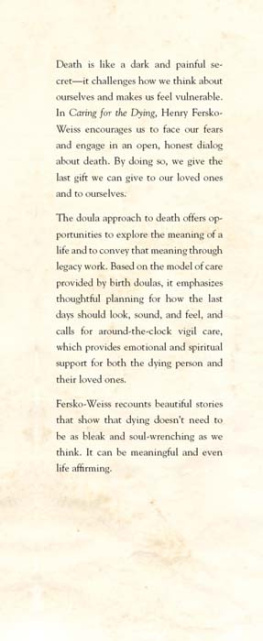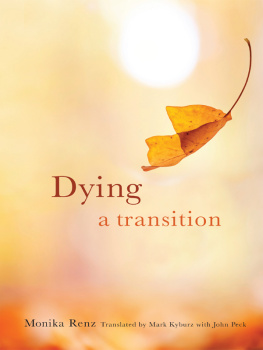Life to Death
HARMONIZING the TRANSITION
RICHARD W. BOERSTLER, PH.D. AND
HULEN S. KORNFELD, R.N., M.A.

H EALING A RTS P RESS
R OCHESTER , V ERMONT
To Claire M. Hinman,
who has been both a dear friend and a generous benefactor.
Without her continuous encouragement and support,
our research and educational work could never
have been accomplished.
A CKNOWLEDGMENTS
This book is the product of many years of sustained commitment by the authors, each of whom has been dedicated to adapting emerging body-mind theories to chronically and terminally ill patients. We are most grateful to the many people who have encouraged our work, including our families and clients. We could not have considered this project without home support, especially from George Kornfeld and Dorothy Boerstler. We have addressed, and been touched by, many people from all walks of life and all levels of health and need in our workshops and lectures and through direct client care. We have been encouraged by advocates within patient-care and support groups, hospital-based programs, hospices, home-care agencies, long-term-care facilities, university classrooms, and many professional conferences, as well as by private-counseling and care-management clients, who have all provided us with opportunities to share our approaches. In turn, our own lives have been enriched as our many contacts opened themselves to us.
We are grateful to all who have contributed to our personal and professional development, and especially to those whose challenges and aggravations have provided the foundation for our work. We have experienced our greatest rewards as our professional and lay teachers have become our friends. Because we have benefited from such a diverse population and have had such broad-ranging experiences, we have sought to blend these influences into our work with clients and into our public presentations.
Without the experiences we shared with our very special clients, we would have nothing but theory. Many people are described in these pages, but we have used other names and varied some details to protect our patients right to confidentiality.
We want to offer our deepest appreciation to our publisher, Ehud Sperling, and the Inner Traditions International staff. We especially wish to acknowledge the helpful guidance of Cannon M. Labrie, our editor. His patience and thoughtful suggestions have been invaluable.
We are especially indebted to the many professors and program planners who have invited us to present our lecture-demonstrations to receptive and responsive groups throughout the last sixteen years. The process has been reinforcing and professionally maturing, and we often feel we walk away with as much as we have given. Those programs have served as the foundation of our text.
We particularly want to thank Caroline Jo Dorr, our mentor, friend, and advocate, under whose guidance our studies in thanatology developed; and Professor Joseph G. Green and his wife, Patricia, who have consistently encouraged our work, stimulated our thoughts, and joined our ventures. In addition, we are thankful to have had the support and intellectual camaraderie of a very special group: The Associates. Each member has contributed to our perceptions and our visions of the possible. Most notably, we recognize the late Anne Wallens, L.I.C.S.W., whose wisdom and sharing consistently reinforced us; and Arlene McGrory, D.Sc.N., who has shared our vision of a holistic approach to terminal care.
Glora Winstock, Professor Dan Baer, Professor Bodo Reichenback, Lucille Mullaly with her Cape Cod group, Professor Alan Anderson, Alan Parker, Edward Bednar, and Ann Duncan-Treviranus have each encouraged our work and our musings throughout the years. Our professional growth has developed because we have been influenced by the pioneering work as well as the encouragement of Dr. Avery D. Weisman, Dr. Therese A. Rando, Professor Kenneth Ring, Dr. Patricia Norris, Rabbi Earl A. Grollman, Dr. David Meagher, Professor Kenneth Kramer, Professor Jonathan Earle, and Anya Foos-Graber. These distinguished scholars, and many others, have inspired us through both their published works and their personal validation. We hope to prove ourselves worthy.
C ONTENTS
I NTRODUCTION

The wise man looks at death with honesty, dignity, and calm, recognizing that the tragedy it brings is inherent in the great gift of life.
Corliss Lamont, Issues of Immortality
This book is as much about life as it is about death and dying. It is about easing the process of illness and dying, and reducing anxiety and stress. It is for everyone who is concerned about coping with emotional and physical changes as vital issues. It reflects on concepts of immortality as they affect fears and provide solace. This book differs from others about death and dying and the body-mind, because it is intended for caregivers of many levels and for people from different backgrounds as they develop their own attitudes and health plans. Practical issues as well as philosophical questions are presented, because both are necessary in life and death.
We present in this book a technique called comeditation, which can relieve the pain and anxiety felt by any individual, even one who is seriously ill. Most especially, it can ease the transition experienced by one who is dying. Though an ancient practice originally developed in Tibet, the technique is entirely suitable for use in our time and society. Comeditation is easily learned and practiced, and its benefits are experienced not only by the ill or dying person but by that persons family and other loved ones.
Unlike meditation as it is commonly understood, comeditation requires two participants: the ill or dying person who is referred to in this book as the recipient, the subject, or the primary meditator, and the person giving the comeditation, referred to as the helper, the assistant, the facilitator, or the comeditator.
Harmonizing the Transition
Each of us acts as an instrument within our worlds ensemble. The tones, the pitch, the nuances from one influence the others. In turn, we each respond with periods of silence and crescendo that are stimulated by the modulations and discords that resonate within ourselves. Anxiety, distraction caused by pain, and many other rambling thoughts interfere with the process of rebalancing the body, a process that takes place in deep relaxation or with a good nights sleep.
Comeditationa method by which a person who wishes to relax is aided by a companion who vocalizes specific sounds, approved or chosen by the first person, in exact synchrony with that persons exhalationsallows the body to completely relax, with consequent release of both physical and mental tension. The mind becomes clearer and more able to focus calmly; the fully relaxed body regulates itself through natural rebalancing. Pain lessens, anxieties can be viewed more objectively, relationships become richer, and a deeper assurance of personal values may emerge. Physical discomfort and emotional unrest become soothed, uniquely, through social support and spiritual awareness.
When inner anxiety prevails, it causes turbulence in every other aspect of a persons life. Various relaxation methods have been shown to improve overall mental and physical function. We particularly advocate comeditation as a vehicle for calming the mind, relaxing the body, and easing the spirit, because the assistance of another helps to override a mind that spins when discomforts or distractions inhibit focusing. As an adjunct to care, comeditation may be combined with any treatment method, and it may be expected to complement the effects of other treatments.
Next page
